1998 GMC SIERRA overheating
[x] Cancel search: overheatingPage 153 of 452
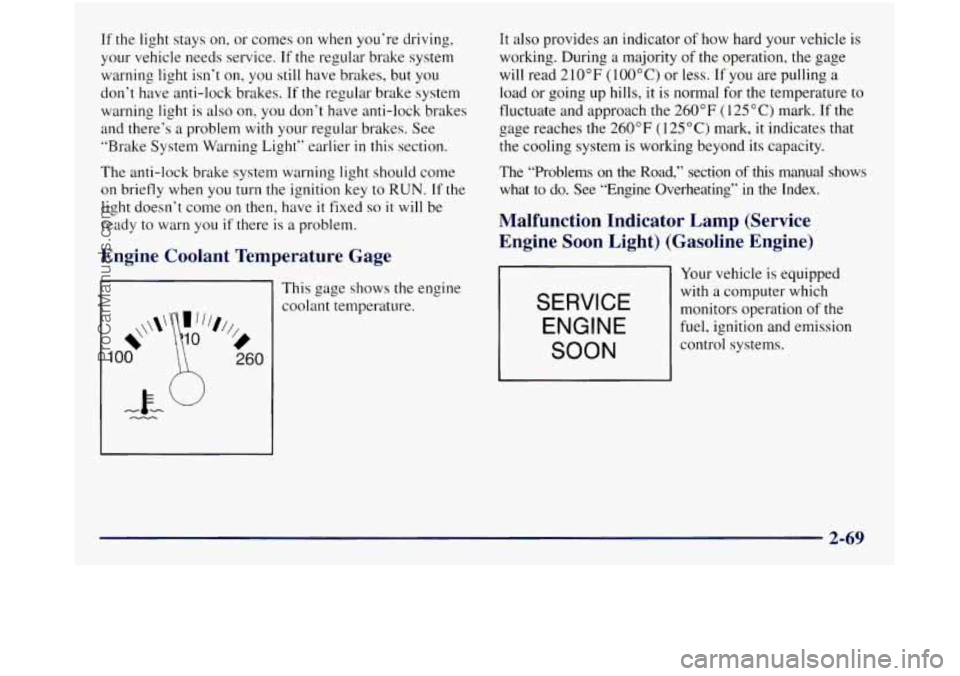
If the light stays on, or comes on when you’re driving,
your vehicle needs service.
If the regular brake system
warning light isn’t on, you still have brakes, but you
don’t have anti-lock brakes.
If the regular brake system
warning light is also on, you don’t have anti-lock brakes
and there‘s a problem
with your regular brakes. See
“Brake System Warning Light” earlier
in this section.
The anti-lock brake system warning light should come
on briefly when you turn the ignition key to RUN. If the
light doesn‘t come on then. have it fixed
so it will be
ready to warn you
if there is a problem.
Engine Coolant Temperature Gage
1
This gage shows the engine
coolant temperature.
It also provides an indicator of how hard your vehicle is
working. During a majority of the operation, the gage
will read
210°F (100°C) or less. If you are pulling a
load or going up hills, it is normal for the temperature to
fluctuate and approach the
260°F (1 25 “C) mark. If the
gage reaches the
260°F (125°C) mark, it indicates that
the cooling system is working beyond its capacity.
The “Problems on
the Road,” section of this manual shows
what
to do. See “Engine Overheating” in the Index.
Malfunction Indicator Lamp (Service
Engine
Soon Light) (Gasoline Engine)
SERVICE
ENGINE
SOON
Your vehicle is equipped
with a computer which
monitors operation
of the
fuel, ignition and emission
control systems.
2-69
ProCarManuals.com
Page 246 of 452
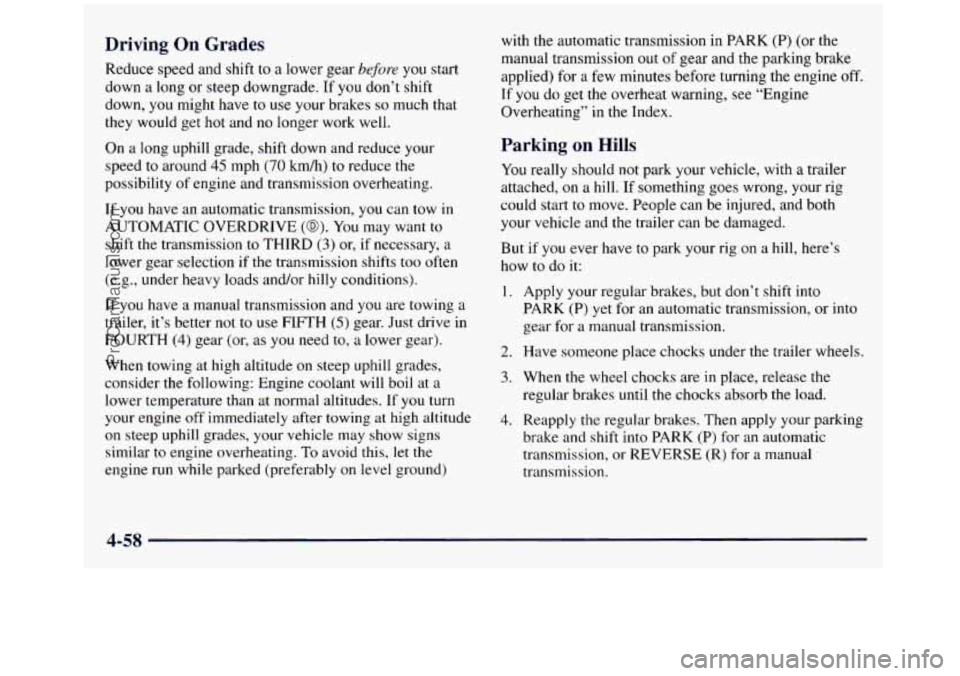
Driving On Grades
Reduce speed and shift to a lower gear before you start
down a long or steep downgrade. If
you don’t shift
down,
you might have to use your brakes so much that
they would
get hot and no longer work well.
On a long uphill grade, shift down and reduce your
speed
to around 45 mph (70 kdh) to reduce the
possibility
of engine and transmission overheating.
If you have an automatic transmission, you can tow in
AUTOMATIC OVERDRIVE
(@). You may want to
shift the transmission
to THIRD (3) or, if necessary, a
lower gear selection
if the transmission shifts too often
(e.g., under heavy loads and/or hilly conditions).
If
you have a manual transmission and you are towing a
trailer, it’s better not to
use FIFTH (5) gear. Just drive in
FOURTH
(4) gear (or, as you need to, a lower gear).
When towing at high altitude
on steep uphill grades,
consider the following: Engine coolant
will boil at a
lower temperature than at normal altitudes. If you turn
your engine off immediately after towing
at high altitude
on steep uphill grades, your vehicle may show signs
similar to engine overheating. To avoid this, let the
engine run while parked (preferably on level ground) with
the automatic transmission in
PARK (P) (or the
manual transmission out of gear and the parking brake
applied) for a few minutes before turning the engine
off.
If you do get the overheat warning, see “Engine
Overheating’’ in
the Index.
Parking on Hills
You really should not park your vehicle, with a trailer
attached, on a
hill. If something goes wrong, your rig
could start to move. People can be injured, and both
your vehicle and the trailer can be damaged.
But
if you ever have to park your rig on a hill, here’s
how to do it:
1.
2.
3.
4.
Apply your regular brakes, but don’t shift into
PARK
(P) yet for an automatic transmission, or into
gear for a manual transmission.
Have someone place chocks under the trailer wheels.
When the wheel chocks are
in place, release the
regular brakes until the chocks absorb the load.
Reapply the regular brakes. Then apply your parking brake and
shift into PARK (P) for an automatic
transmission, or REVERSE (R)
for a manual
transmission.
4-58
ProCarManuals.com
Page 253 of 452
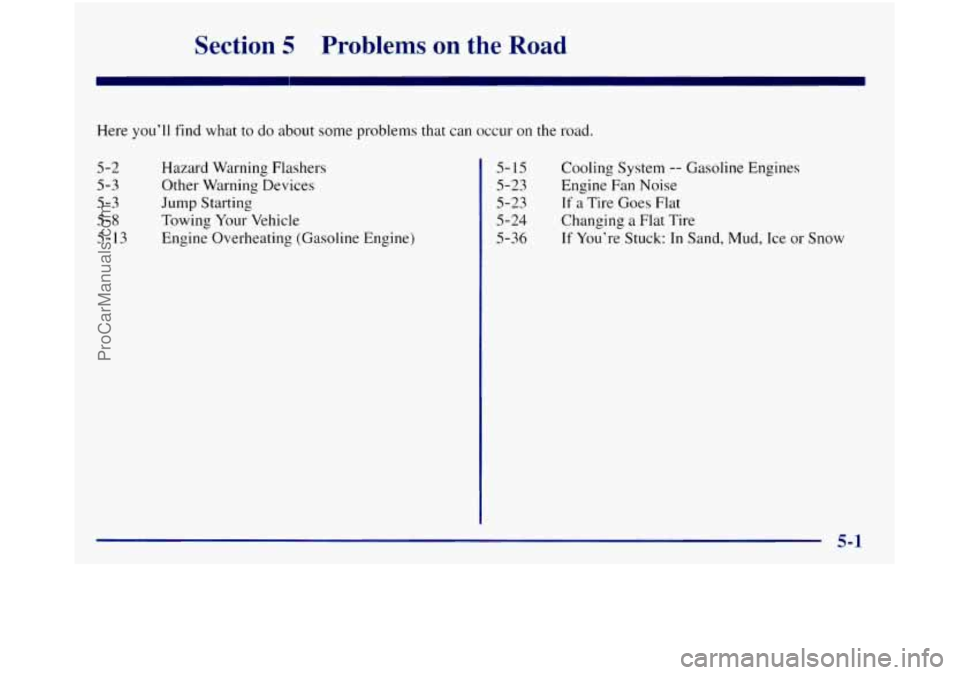
SI ;tion 5 Problems on the Road
Here you’ll find what to do about some problems that can occur on the road.
5-2
5-3
5-3
5-8
5- 13
Hazard Warning Flashers
Other Warning Devices
Jump Starting
Towing Your Vehicle
Engine Overheating (Gasoline Engine) 5- 15
5-23
5-23
5-24
5-36
Cooling System -- Gasoline Engines
Engine Fan Noise
If a Tire Goes Flat
Changing a
Flat Tire
If You’re Stuck: In Sand, Mud, Ice or Snow
5-1
ProCarManuals.com
Page 265 of 452
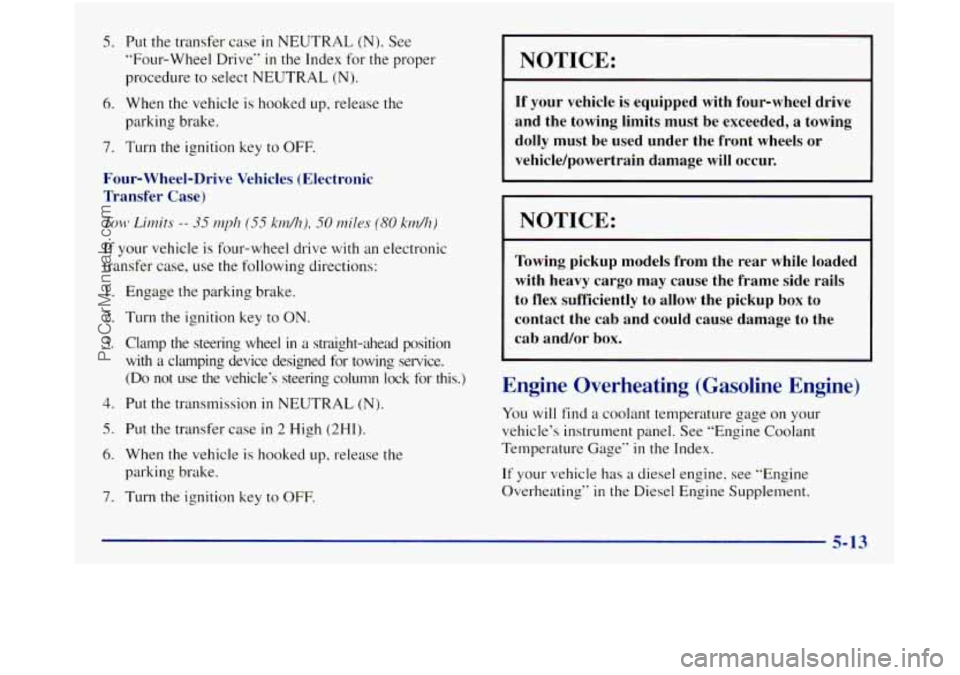
5. Put the transfer case in NEUTRAL (N). See
“Four-Wheel Drive’’
in the Index for the proper
procedure to select NEUTRAL
(N).
6. When the vehicle is hooked up. release the
parking brake.
7. Turn the ignition key to OFF.
Four- Wheel-Drive Vehicles (Electronic
Transfer Case)
Eml Limits -- 35 mph (55 km/JZ), 50 milc?s (80 kndh)
If your vehicle is four-wheel drive with an electronic
transfer case, use the following directions:
I. Engage the parking brake.
2. Turn the ignition key to ON.
3. Clamp the steering wheel in a straight-ahead position
with
a clamping device designed for towing service.
(Do not use the vehicle’s steering column lock for this.)
4. Put the transmission in NEUTRAL (N).
5. Put the transfer case in 2 High (2HI).
6. When the vehicle is hooked up, release the
parking brake.
7. Turn the ignition key to OFF.
NOTICE:
If your vehicle is equipped with four-wheel drive
and the towing limits must be exceeded, a towing
dolly must be used under the front wheels or
vehicle/powertrain damage will occur.
I NOTICE:
Towing pickup models from the rear while loaded
with heavy cargo may cause the frame side rails
to flex sufficiently to allow the pickup box to
contact the cab and could cause damage to the
cab and/or box.
Engine Overheating (Gasoline Engine)
You will find a coolant temperature gage on your
vehicle’s instrument panel. See “Engine Coolant
Temperature Gage”
in the Index.
If your vehicle has a diesel engine, see “Engine
Overheating”
in the Diesel Engine Supplement.
5-13
ProCarManuals.com
Page 318 of 452

How to Check Lubricant
If the level is below the bottom of the filler plug hole,
you may need to add some lubricant.
When the differential is cold, add enough lubricant to
raise the level to 1/2 inch (12
mrn) below the filler
plug hole.
When the differential is at operating temperature
(warm), add enough lubricant to raise the level to the
bottom
of the filler plug hole.
What to Use
Refer to the Maintenance Schedule to determine what
kind of lubricant to use. See “Recommended Fluids and
Lubricants” in the Index.
Engine Coolant
The cooling s stem in your vehicle is filled with
DEX-COOL engine coolant. This coolant is designed
~
to remain in your vehicle for 5 years or 150,000 miles I
(240 000 km) whichever occurs first, if you add only ~
DEX-COOL’ extended life coolant.
8
The following explains your cooling system and how
to add coolant when it is low. If you have a problem
i
with engine overheating, see “Engine Overheating” in 1
the Index.
A 50/50 mixture of water and DEX-COOL@ coolant will: 1
0 Give freezing protection down to -34°F (-37°C).
0 Give boiling protection up to 265 OF (1 29 O C).
Protect against rust and corrosion.
0 Help keep the proper engine temperature.
0 Let the warning gages work as they should.
6-28 ;L
ProCarManuals.com
Page 322 of 452
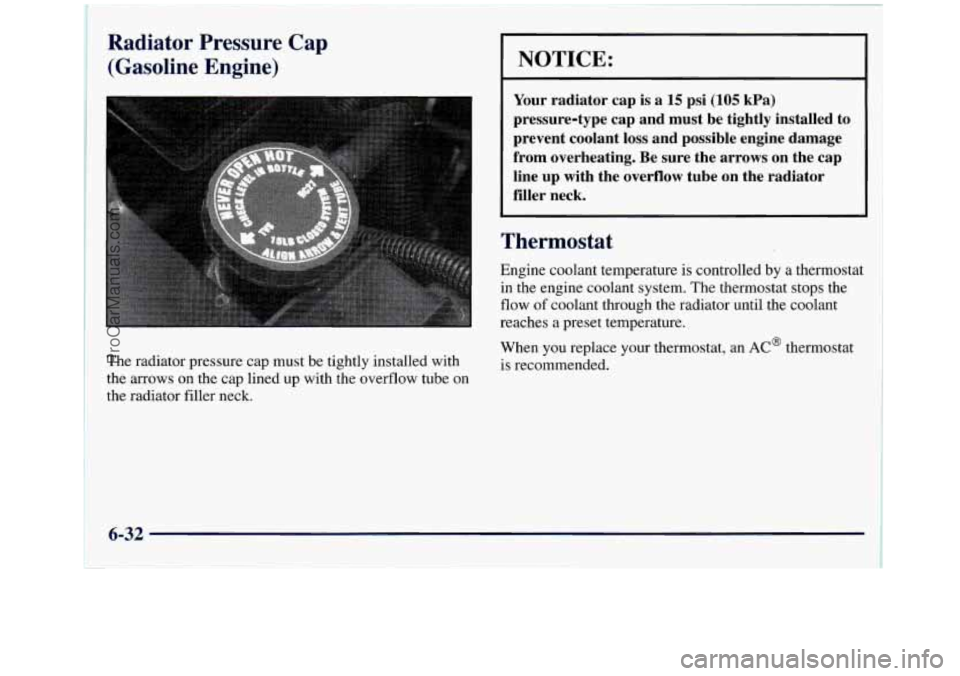
Radiator Pressure Cap
(Gasoline Engine)
The radiator pressure cap must be tightly installed with
the arrows
on the cap lined up with the overflow tube on
the radiator filler neck.
~~~ ~
NOTICE:
Your radiator cap is a 15 psi (105 kPa)
pressure-type cap and must be tightly installed to
prevent coolant loss and possible engine damage
from overheating. Be sure the arrows on the cap
line up with the overflow tube on the radiator
filler neck.
Thermostat
Engine coolant temperature is controlled by a thermostat
in the engine coolant system. The thermostat stops the
flow of coolant through the radiator until the coolant
reaches a preset temperature.
When you replace your thermostat, an
AC@ thermostat
is recommended.
6-32
ProCarManuals.com
Page 341 of 452
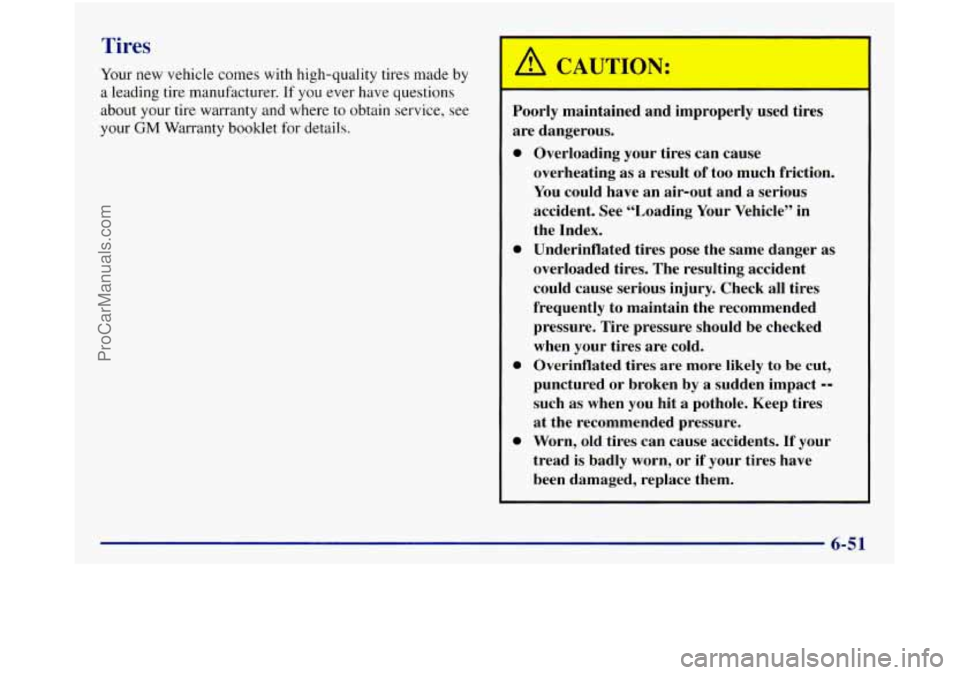
Tires
Your new vehicle comes with high-quality tires made by
a leading tire manufacturer.
If you ever have questions
about your tire warranty and where to obtain service, see
your
GM Warranty booklet for details.
A CAUTION:
Poorly maintained and improperly used tires
are dangerous.
0
0
0
0
Overloading your tires can cause
overheating as
a result of too much friction.
You could have an air-out and
a serious
accident. See “Loading Your Vehicle” in
the Index. Underinflated tires pose the same danger as
overloaded tires. The resulting accident could cause serious injury. Check all tires
frequently to maintain the recommended
pressure. Tire pressure should be checked when your tires are cold.
Overinflated tires are more likely to be cut,
punctured
or broken by a sudden impact --
such as when you hit a pothole. Keep tires
at the recommended pressure.
Worn, old tires can cause accidents. If your
tread is badly worn, or if your tires have
been damaged, replace them.
6-51
ProCarManuals.com
Page 441 of 452

Manual Transmission Check
...................................... 7-41
Fluid
.................................. 6.24, 7.46
Shifting
................................ 2- 18. 2. I9
Starting Your Engine .......................... 2- 13
Manualwindows
............................... 2-32
Memo Pad Holder
......................... 2.55. 2.57
Methanol
...................................... 6- 5
Mirrors ....................................... 2-45
CamperType
................................ 2-48
Convex Outside
.............................. 2-50
Electrochromic Daymight Rearview
.............. 2-46
Inside Daymight Rearview
..................... 2-45
Manual
..................................... 2-48
Power Remote Control
......................... 2-50
WestCoastType
.............................. 2-50
MMT
......................................... 6-4
Model Reference
................................. vi
MountainRoads ................................ 4-34
New Vehicle Break-In
.......................... 2- 10
Nightvision ................................... 4-27
Noise Control System ........................... 6- 13
Normal Maintenance. Normal Replacement Parts
...... 6-78
Odometer
.................................... 2-63
Odometer. Trip
................................. 2-63
Off-Road Driving
.............................. 4- I4
Off-Road Recovery
............................. 4- I I
Oil. Engine ............................... 6-14. 7-46
Opener. Garage Door
............................ 2-51
Overheating Engine ............................. 5- 13 Owner Checks
and Services
....................... 7-40
Owner Publications. Ordering
................ 8- 1 1. 8- 12
Paint Spotting. Chemical
........................ 6-68
Park. Shifting Into
.............................. 2-26
Park. Shifting Out of
............................ 2-29
Parking
AtNight
..................................... 2-9
Brake
...................................... 2-25
Brake Mechanism Check
....................... 7-43
Over Things That Burn
........................ 2-30
With a Trailer ................................ 4-58
Your Vehicle. Manual Transmission
.............. 2-29
Passenger Position
.............................. 1-23
Lots
........................................ 2-9
Passin;
@ ..................................... 4-11
Passlock
................................ 2- 10, 2-73
Periodic Maintenance Inspections
.................. 7-44
Pickup Box Identification Lamp Bulb Replacement
.... 6-47
Pickup Conversion to Chassis Cab
................. 4-48
Power
Accessory Outlet
............................. 2-59
DoorLocks
................................... 2-6
Driver’sSeat ................................. 1-3
Option Fuses
................................ 6-71
Remote Control Mirror
........................ 2-50
Steering ..................................... 4-8
Steering Fluid ........................... 6-33, 7-46
Take-Off .................................... 4-61
Winches
.................................... 4-61
Windows
................................... 2-32
ProCarManuals.com